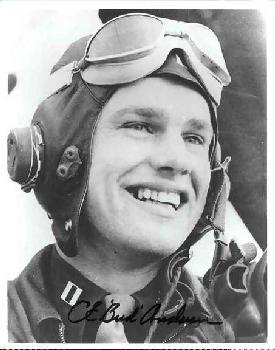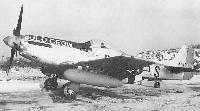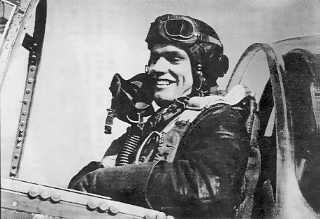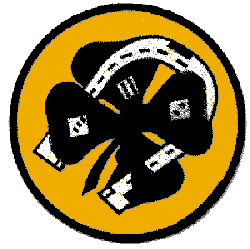Clarence 'Bud' Anderson
![]()
 A
native of Newcastle, California, Captain Anderson flew 116 sorties with the 362nd FS of
the 357th Fighter Group, scoring 16.25 victories, the fourth-ranking ace of that
outstanding group.
A
native of Newcastle, California, Captain Anderson flew 116 sorties with the 362nd FS of
the 357th Fighter Group, scoring 16.25 victories, the fourth-ranking ace of that
outstanding group.
He described how he felt before his first mission: "My pulse was playing a Gene Krupa solo as I walked to my plane that morning and climbed into the cockpit. Once you were strapped in there, so very alone, the minutes crawled by. Later on I used this time to focus on the mission, thinking about what lay ahead, and preparing the way an athlete prepares for a game. But on February 8, 1944 I was a little less sophisticated about that sort of thing. I had logged 893 flying hours already, better than an hour and twenty minutes a day for two years. But only 30 hours and 45 minutes of that was in P-51s. I knew I had lots to learn. And what I was thinking about before prodding the Merlin to life was of not getting lost, not screwing up. I was more afraid of screwing up than of dying.
 In his aircraft Old Crow, he had a couple of
skirmishes with the German jets. He "butchered" his chance to shoot down the
first one he saw, an Me-262 flying under him before his group had joined up with their
bombers. Thinking to dive and build up speed, Anderson dropped his external fuel tank
without switching to internal fuel first. His engine quit cold! He immediately re-started
and thought he still had a chance to get the jet. But as he closed in, the jet "just
shrank up and vanished behind the gunsight's bull's-eye of light."
In his aircraft Old Crow, he had a couple of
skirmishes with the German jets. He "butchered" his chance to shoot down the
first one he saw, an Me-262 flying under him before his group had joined up with their
bombers. Thinking to dive and build up speed, Anderson dropped his external fuel tank
without switching to internal fuel first. His engine quit cold! He immediately re-started
and thought he still had a chance to get the jet. But as he closed in, the jet "just
shrank up and vanished behind the gunsight's bull's-eye of light."
"On November 27 we tried some new tactics. As a ruse, the Mustangs of the 353rd Group arranged themselves in bomber formation and our planes flew the standard zigzag escort pattern above them. The idea was to fool the German radar and scramble the interceptors. It worked almost too well. They threw themselves at us 100 miles southwest of Berlin. The fighter pilots must have had coronaries when they discovered what they were attacking, - not B-17s, but more than 100 fighters spoiling for trouble. Our pulses jumped too, for they came in insect-like clouds we called gaggles.
 "It was the biggest concentration
of enemy planes I'd ever seen! They came in two clusters of 80 to 100 planes each, mostly
Focke-Wulfs. They were coming at us almost head-on, at eleven o'clock; we turned into them
as they passed and all hell broke loose. I fell on a straggler who broke smartly and ran
for the deck. Letting him go, I picked out another 190 ahead at about 31,000 feet, closed
to within 250 yards, and hammered him with a burst that made flashes all over the
fuselage. He rolled over slowly, too slowly, and fell into a spin. The pilot must have
been dead. I turned away, looking for other targets. There were airplanes darting all over
the sky."
"It was the biggest concentration
of enemy planes I'd ever seen! They came in two clusters of 80 to 100 planes each, mostly
Focke-Wulfs. They were coming at us almost head-on, at eleven o'clock; we turned into them
as they passed and all hell broke loose. I fell on a straggler who broke smartly and ran
for the deck. Letting him go, I picked out another 190 ahead at about 31,000 feet, closed
to within 250 yards, and hammered him with a burst that made flashes all over the
fuselage. He rolled over slowly, too slowly, and fell into a spin. The pilot must have
been dead. I turned away, looking for other targets. There were airplanes darting all over
the sky."
In the fall of 1944, the 357th combat-tested the new G-suits that had been developed for pilots, as Bud Anderson recounts. "The Mustangs could take very hard turns. Long before the wings flew off, the pilots would lose consciousness. Five G's and you might "gray out" but be able to function. Six G's or so and you would black out completely. The form-fitting suits inflated as the airplane pulled G's, hugging you, and preventing the blood from leaving your head all at once. There were two experimental suits. One was water-filled, and turned out to be too cold at six miles up, even when filled with warm water on the ground. The other ones, air suits, drew air from the pressure side of the engine's vacuum pump. These suits wrapped around your abdomen, thighs, and calves, and inflated automatically. These worked much better."
"With the G-suits, we could fly a little harder, turn a little tighter. We could pull maybe one extra G now, which gave us an edge. There was no resistance to wearing them as we understood that wearing them was the same as making the airplane better."
Anderson stayed with the USAF after the war, as a test pilot for many years, and flying F-105s in Vietnam.

362nd FS
Sept. 1942 - Graduated from Pilot Training, assigned to 328th FG at Hamilton Field, CA. flying the P-39
Sept. 1943 - Joined the 363rd FS, 357th FG at Tonapah NV
Nov. 1943 - 357th FG shipped to England, assigned to 8th Air Force
03-08-44 - Anderson's first victory: Bf-109 trying to kill a straggling B-17 on one of the first Berlin missions.
04-11-44 - Hanover, Germany: Bf-109 and partial He-111 victories
04-30-44 - France: FW-190 victory
05-08-44 - Berlin mission: FW-190 victory
05-12-44 - Brux, Germany: Bf-109 victory
05-27-44 - Ludwigshafen, Germany: two Bf-109 victories, (one trying to outclimb then outrun the P-51, the other trying to stall and get in behind)
05-30-44 - Bernberg, Germany: Bf-109 victory
06-29-44 - Leipzig, Germany: three FW-190 victories - BIG DAY!!
07-07-44 - Leipzig, Germany: Bf-109 victory
July 1944 - On leave in United States
Fall 1944 - Returned to 357th FG
Hall of Fame WWII | U. S. Fighter | Feedback